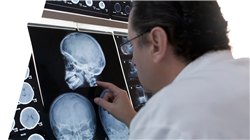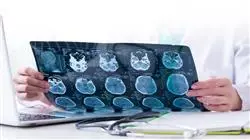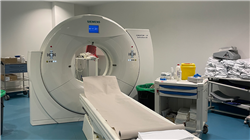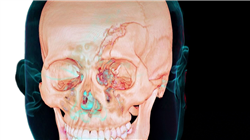University certificate
The world's largest faculty of medicine”
Why study at TECH?
Thanks to this Hybrid professional master’s degree, you will analyze the physical and biological evidence in a meticulous way. You will contribute to solving the most complex criminal cases!”

The intersection between Psychiatry and the judicial system has given rise to the specialty of Forensic Psychiatry, a crucial discipline for the evaluation of the mental competence of defendants. According to a recent study, approximately 55% of criminal cases require psychiatric evaluations to determine the defendants' competency to stand trial. In the face of this, professionals play a key role in the proper assessment of mental competency.
Therefore, it is necessary for these specialists to incorporate into their procedures the most advanced methodologies to help determine the psychological capacity and legal responsibility of individuals involved in legal cases.
Within this framework, TECH presents a pioneering Hybrid professional master’s degree in Legal and Forensic Medicine. Under a theoretical-practical approach, the academic itinerary will delve into aspects ranging from Thanatology or Forensic Pathology to the Evaluation of Damage. In this way, graduates will develop advanced skills to analyze evidence in a precise manner. At the same time, the syllabus will provide experts with skills in the collection, preservation and evaluation of evidence at crime scenes. In this way, professionals will perform detailed autopsies that will determine the cause of death and contribute to the clarification of criminal cases.
Moreover, TECH has developed an academic pathway based on flexibility. The only thing doctors will need is an electronic device with Internet access to enter the Virtual Campus and enjoy the most dynamic academic content on the market. In addition, this virtual platform offers a library full of multimedia resources (such as interactive summaries, case studies or specialized readings) to strengthen learning and ensure that it is enjoyable.
You will be highly qualified to interpret DNA evidence and apply this information to identify victims”
This Hybrid professional master’s degree in Legal and Forensic Medicine contains the most complete and up-to-date scientific program on the market. The most important features include:
- Development of more than 100 clinical cases presented by professionals in Legal and Forensic Medicine.
- The graphic, schematic, and practical contents with which they are created, provide scientific and practical information on the disciplines that are essential for professional practice.
- It contains practical exercises where the self-evaluation process is carried out to improve the learning process.
- Algorithm-based interactive learning system for decision making in the situations that are presented to the student
- With special emphasis on evidence-based Medicine and research methodologies in Forensic and Legal Medicine.
- All of this will be complemented by theoretical lessons, questions to the expert, debate forums on controversial topics, and individual reflection assignments
- Content that is accessible from any fixed or portable device with an Internet connection
- In addition, they will be able to complete a clinical internship at distinguished institutions.
After passing the theoretical phase, you will carry out an intensive 3-week internship in a prestigious institution, where you will acquire all the knowledge you need to take a leap in your career as a Forensic Physician”
In this proposed Hybrid professional master’s degree, of a professionalizing nature and blended mode, the program is aimed at updating medical professionals in the field of Legal and Forensic Medicine. The contents are based on the latest scientific evidence, and oriented in a didactic way to integrate theoretical knowledge in practice, and the theoretical-practical elements will facilitate the updating of knowledge and will allow decision making in patient management.
Thanks to its multimedia content elaborated with the latest educational technology, they will allow Legal and Forensic Medicine professionals to obtain a situated and contextual learning, that is to say, a simulated environment that will provide an immersive learning programmed to specialize in real situations. This program is designed around Problem-Based Learning, whereby the physician must try to solve the different professional practice situations that arise during the course. For this purpose, students will be assisted by an innovative interactive video system created by renowned and experienced experts.
This Hybrid professional master’s degree allows you to practice first in simulated environments, which provide immersive learning and then in the real hospital environment, testing everything you have studied"

Update your knowledge through this theoretical and practical master's degree, in a practical way and adapted to your needs"
Teaching Planning
This itinerary has been elaborated by recognized experts in Legal and Forensic Medicine, who bring to the didactic materials both their solid knowledge of this subject and years of professional experience. Through 10 specialized modules, the program will provide specialists with the most sophisticated techniques to identify toxic substances in the human body. Likewise, the syllabus will delve into the changes that occur in the body after death. Therefore, graduates will be able to estimate the time of death. In addition, they will acquire the skills to write detailed reports that can be used in legal proceedings.

You will incorporate into your daily practice the most innovative techniques of evidence collection, preservation and analysis”
Module 1. Update
1.1. Medical Expert Evidence in the Different Fields of Law
1.1.1. Concept of Expert Evidence
1.1.2. Sections of Expert Evidence
1.1.3. Legal Applications of Expert Evidence
1.2. Forensic Medicine Systems in America and Europe
1.2.1. Main Differences between Systems
1.2.2. Legal Amendments between Countries
1.3. Expert Investigation and Method
1.3.1. Research Techniques
1.3.2. Research Limits
1.3.3. Legal Aspects of Research
1.4. Ethics and Expert Evidence
1.4.1. Professional Ethics
1.4.2. Objectivity in Expertise
1.4.3. Subjectivity in Expertise
1.4.4. Oath according to the Civil Procedure Law
1.5. Professional Responsibility of the Medical Expert
1.5.1. Civil Liability Insurance
1.5.2. Concept of Expert Liability
1.5.3. Aspects of the Civil Procedure Law
Module 2. Forensic Thanatology
2.1. Generalities
2.1.1. Concept and Content
2.1.2. Concepts of Death
2.1.3. Degrees of Death
2.2. Legal Transcendence
2.3. Mortuary Progression
2.3.1. Agony Indicators
2.3.2. Precedence in Multiple Deaths
2.4. How is Death Diagnosed?
2.4.1. Concept and Methodology
2.5. Death Demonstrated
2.5.1. Encephalic Death
2.5.2. Death in Cardiac Arrest
2.6. Cadaveric Phenomena
2.6.1. Concept
2.6.2. Classification
2.7. Cooling
2.7.1. Production Mechanism
2.8. Dehydration, Lividity, and Hypostasis
2.8.1. Production Mechanism
2.9. Stiffness and Spasms
2.9.1. Production Mechanism
2.10. Autolysis and Putrefaction
2.10.1. Chronology of Putrefaction
2.11. Preservative and Transformative Phenomena of the Cadaver. Saponification
2.11.1. Concept and Classification
2.12. Preservative and Transformative Phenomena of the Cadaver Mummification
2.12.1. Concept
2.12.2. Phases of the Process
2.13. Preservative and Transformative Phenomena of the Cadaver. Corification
2.13.1. Concept
2.13.2. Phases of the Process
2.14. Other Cadaveric Phenomena
2.14.1. Concept
2.14.2. Phases
2.15. Duration of Death
2.15.1. Concept and Importance
2.15.2. Routines and Means of Dating Death
2.16. Criminal Judicial Autopsy and Civil Judicial Autopsy
2.16.1. Definition and Methodology
2.16.2. Forms of Action
2.17. Autopsy Times
2.17.1. External Cadaveric Examination
2.17.2. Internal Cadaveric Examination
2.18. Auxiliary Techniques for Forensic Medical Necrodiagnosis
2.18.1. Classification and Concept
2.19. Vital, Perimortal, and Postvital Injuries
2.19.1. Origin
2.19.2. Routines
2.19.3. Diagnostic Methods
2.20. Discovery of the Corpse
2.20.1. Removal of the Corpse
2.20.2. Site Inspection
Module 3. Forensic Pathology I
3.1. Death due to Injury
3.1.1. Classification
3.1.2. Destruction of Vital Centers
3.1.3. Hemorrhages
3.2. Traumatic Shock and Embolisms
3.2.1. Concept
3.2.2. Production Mechanism
3.3. Multiorgan Dysfunction Syndrome
3.3.1. Definition and Concept
3.4. Mechanisms of Natural Death
3.4.1. Concept and Classification
3.5. Natural Death of Cardiovascular and Respiratory Origin
3.5.1. Concept and Classification
3.6. Natural Death of Neurological Origin
3.6.1. Concept and Diagnosis
3.7. Natural Death of Digestive and Metabolic Origin
3.8. Sudden Infant Death
3.8.1. Classification
3.8.2. Possible Disguised Deaths (Abuse)
3.9. Sudden Adult Death
3.9.1. Concept and Classification
3.10. Study of Contusions
3.10.1. Signs of Struggle
3.10.2. Signs of Defense
3.11. Stab Wounds
3.11.1. Types of Wounds
3.11.2. Production Mechanism
3.12. Gunshot Wounds
3.12.1. Types of Wounds
3.12.1.1. Entry Wounds
3.12.1.2. Exit Wounds
3.12.1.3. Production Mechanism
3.13. Electrical Injuries
3.13.1. Concept
3.13.2. Production Mechanism
3.14. Cold, Radiation, and Atmospheric Pressure Injuries
3.14.1. Concept
3.14.2. Classification
3.14.3. Production Mechanism
3.15. Heat Injuries and Burns
3.15.1. Concept
3.15.2. Classification
3.15.3. Identification
3.16. Fire Injuries
3.16.1. Concept
3.16.2. Classification
3.16.3. Identification
3.17. Blast Injuries
3.18. Major Disasters
Module 4. Forensic Pathology II
4.1. Domestic Abuse
4.1.1. Concept
4.1.2. Detection
4.1.3. Diagnosis
4.2. Child Abuse
4.2.1. Concept
4.2.2. Detection
4.2.3. Diagnosis
4.3. Child Sexual Abuse
4.3.1. Concept
4.3.2. Detection
4.3.3. Diagnosis
4.4. Abuse in Relationships
4.4.1. Concept
4.4.2. Detection
4.4.3. Diagnosis
4.4.4. Possible False Abuse
4.5. Elder Abuse
4.5.1. Concept
4.5.2. Detection
4.5.3. Diagnosis
4.6. Traffic Accident Injuries
4.6.1. Concept
4.6.2. Classification
4.7. Forensic Medical Investigation of Aircraft Accidents
4.7.1. Concept
4.7.2. Basic Notions
4.8. Mechanical Asphyxiation
4.8.1. Concept
4.8.2. Classification
4.9. Mechanisms of Death
4.9.1. Common Injuries in Deaths due to Asphyxiation
4.10. Hanging
4.10.1. Concept
4.10.2. Classification
4.10.3. Diagnosis
4.11. Strangulation
4.11.1. Concept
4.11.2. Classification
4.11.3. Diagnosis
4.12. Suffocation
4.12.1. Concept
4.12.2. Diagnosis
4.13. Submersion
4.13.1. Concept
4.13.2. Diagnosis
4.14. Violent Death in Infants
4.14.1. Concept
4.14.2. Relevant Aspects to Identify Possible Aggressions
4.14.3. Relevant Aspects to Identify Possible Aggressors
4.15. Natural and Violent Pathology in Relation to Work
4.15.1. Common Disease
4.15.2. Professional Disease
4.15.3. Occupational Disease
4.15.4. Common Accidents
4.15.5. Occupational Accidents
4.16. Causal Links in the Production of Injuries
4.17. Contents of the Medical Report to Aid the Courts
Module 5. Forensic Sexology
5.1. Crimes Against Sexual Freedom and Indemnity
5.1.1. Concept
5.1.2. Classification
5.2. Pregnancy and Abortion
5.2.1. Concept
5.2.2. Typology
5.2.3. Issues of Interest to the Courts
5.3. Physiological Birth Diagnosis
5.3.1. Concept
5.3.2. Issues of Interest to the Courts
5.4. Sex Diagnosis
5.4.1. Concept
5.4.2. Issues of Interest to the Courts
5.4.3. Update on Gender Dysphoria
5.5. Sexual Dysfunctions
5.5.1. Concept
5.5.2. Classification
Module 6. Forensic Toxicology
6.1. Introduction
6.1.1. Etiology
6.1.2. Mechanisms
6.2. Gas and Vapor Poisoning
6.2.1. Concept
6.2.2. Classification
6.2.3. Diagnosis
6.3. Poisoning by Caustics, Metals, and Derivatives
6.3.1. Concept
6.3.2. Classification
6.3.3. Diagnosis
6.4. Alcohol and Solvent Poisoning
6.4.1. Concept
6.4.2. Classification
6.4.3. Diagnosis
6.5. Pesticide Poisoning
6.5.1. Concept
6.5.2. Classification
6.5.3. Diagnosis
6.6. Drug, Food, Mushroom, and Venom Poisoning
6.6.1. Concept
6.6.2. Classification
6.6.3. Diagnosis
6.7. Autopsies in Poisoning Deaths
6.7.1. Concept
6.7.2. Etiology
6.7.3. Classification
Module 7. Forensic Psychiatry
7.1. Concept
7.1.1. Objectives
7.1.2. Application
7.2. Imputability
7.2.1. Aspects of Legal Interest
7.2.2. Criminal Law Concepts
7.3. Capacity to Act
7.3.1. Personal Training
7.3.2. Influence of External Agents
7.4. Medical Forensic Aspects of Developmental Disorders
7.5. Medical Forensic Aspects of Deliriums
7.5.1. Dementia
7.5.2. Amnesia
7.5.3. Other Cognitive Disorders
7.6. Medical - Forensic Aspects of Alcohol-Related Disorders
7.6.1. Alcohol Poisoning
7.6.2. The Influence of Alcohol in the Blood
7.7. Medical - Forensic Aspects of Cocaine and Opiate-Related Disorders
7.7.1. Legal Considerations on Consumption
7.7.2. Identification
7.7.3. Influence on the Subject
7.8. Medical - Forensic Aspects of Cannabis and Other Drug-Related
7.8.1. Legal Considerations on Consumption
7.8.2. Identification
7.8.3. Influence on the Subject
7.9. Medical Forensic Aspects of Psychotic Disorders
7.9.1. Schizophrenia
7.10. Medical Forensic Aspects of Psychotic Disorders
7.10.1. Delusional Disorder
7.11. Medical Forensic Aspects of Mood Disorders
7.11.1. Classification
7.11.2. Diagnosis
7.12. Medical Forensic Aspects of Anxiety Disorders
7.12.1. Post-Traumatic Stress Disorder
7.13. Medical Forensic Aspects of Somatoform Disorders
7.13.1. Classification
7.13.2. Diagnosis
7.14. Medical Forensic Aspects of Sexual Orientation Disorders
7.14.1. Classification
7.14.2. Diagnosis
7.15. Medical Forensic Aspects of Impulse Control Disorders
7.15.1. Classification
7.15.2. Diagnosis
7.16. Medical Forensic Aspects of Personality Disorders I
7.16.1. Classification
7.16.2. Diagnosis
7.17. Medical Forensic Aspects of Personality Disorders II
7.17.1. Classification
7.17.2. Diagnosis
Module 8. Damage Assessment
8.1. Medical Assessment of Damage to the Person
8.1.1. Damage Repair
8.2. Medical Assessment
8.2.1. Deficiency
8.2.2. Disability
8.2.3. Handicap
8.3. Medical Assessment
8.3.1. Other Criminal Damages
8.4. Medical Assessment
8.4.1. Other Civil Damages (I)
8.5. Economic and Patrimonial Damages
8.5.1. Assessment
8.5.2. Understanding the Official State Gazette (BOE)
8.6. Medical Assessment
8.6.1. Other Civil Damages (II)
8.7. Medical Assessment
8.7.1. Occupational Damages
8.7.1.1. Classification of Accidents
8.7.1.2. Occupational Risk Prevention
8.7.1.3. Negligence
8.8. The Medical Expert's Mission in Personal Injury Appraisal
8.8.1. Evaluation Guide
8.8.2. BOE
8.9. Methodology in the Valuation of Damage
8.9.1. Evaluation Guide
8.9.2. BOE
8.10. The Medical Report in the Valuation of Damage
Module 9. Forensic Anthropology
9.1. Introduction
9.1.1. Concepts
9.2. Anthropological Analysis
9.2.1. Methodology
9.2.2. Development
9.2.3. Classification
9.3. Determining Certain Aspects of the Subject
9.3.1. Age
9.3.2. Sex
9.3.3. Size
9.4. Dental Identification
9.4.1. Dental Concepts in Children
9.4.2. Dental Concepts in Adults
9.4.3. Classification of Dental Pieces
9.5. Taphonomy
9.5.1. Cadaver-Environment Relationship
9.5.2. Data of the Remains
Module 10. Criminalistics
10.1. Evidence at the Scene
10.1.1. Biological Evidence
10.1.2. Non-Biological Evidence
10.1.3. Sample Collection
10.1.4. Chain of Custody
10.1.5. Classification
10.2. Study of Footprints
10.2.1. Classification
10.2.2. Sample Collection
10.2.3. Methodology

The teaching materials of this program, elaborated by these specialists, have contents that are completely applicable to your professional experiences"
Hybrid Professional Master's Degree in Legal and Forensic Medicine
Legal and Forensic Medicine plays a crucial role in the administration of justice and the clarification of facts related to health, violence and other legal events. If you want to specialize in this exciting field and contribute to the resolution of court cases, the Hybrid Professional Master's Degree in Legal and Forensic Medicine at TECH Global University is the perfect option for you.
Enroll in this program and get a quality education
Our Hybrid Professional Master's Degree is taught in blended mode, which gives you the flexibility to study from anywhere and the opportunity to interact directly with experts and peers in face-to-face sessions. At TECH Global University, we focus on providing you with a quality academic experience, combining the best of both worlds. By joining our program, you'll have access to the most up-to-date resources and a faculty of highly trained professors who will guide you through the study of essential topics in forensic medicine. You will explore areas such as forensic autopsy, corpse identification, assessment of bodily injury and interpretation of forensic evidence. You will learn how to analyze scientific evidence, write expert reports and present testimony in court. The blended learning modality gives you the opportunity to apply your knowledge in practical cases, work in a team and develop effective communication skills. In addition, you will be able to establish professional contacts and expand your network of connections in the forensic field. At TECH Global University, we understand the importance of keeping up to date in a field as dynamic as forensics and forensic medicine. That's why our master's degree is designed to provide you with the most up-to-date knowledge and tools necessary to become an expert in this constantly evolving discipline. If you are looking to excel in the field of Legal and Forensic Medicine, do not miss the opportunity to be part of our Hybrid Professional Master's Degree in TECH Global University. Join us and acquire the knowledge and skills necessary to make a difference in the field of justice and health.







